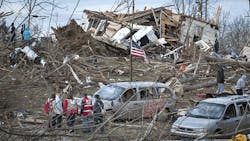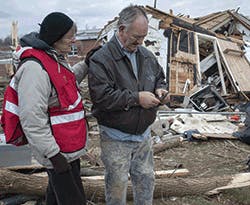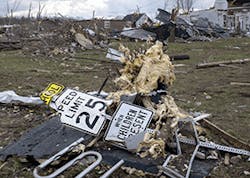Louis Pasteur, the French chemist credited with discovering that heating pathogens could kill harmful bacteria, is credited with the observation, "Chance favors the prepared mind." It's a saying that those in the health and safety field practice on a daily basis, starting with emergency preparedness plans designed to keep businesses operational during times of crisis.
Yet just 38 percent of small businesses have a formal emergency or disaster preparedness plan in place, according to 2012 study published in the Journal of Accountancy. Larger organizations fair better when it comes to having business continuity management (BCM) programs in place, and, according to a Continuity Insights and KPMG 2014 survey, 71 percent of BCM programs have some sort of senior leadership governance capability.
Having this type of executive support is a prerequisite to the success of emergency preparedness and business continuity plans. The next step is to extend this level of awareness to all parts of the organization and build preparedness planning into daily operations.
Changing Attitudes Is Tough
Changing attitudes toward preparedness is difficult, even with management support.
Consider the "If you see something, say something" campaign originally implemented by New York City after the 9/11 attacks. Promoted throughout the northeast to increase public awareness of terrorism, transit facility staff and the transportation-riding public were told to be on the lookout for suspicious packages.
This slogan was later adopted by the Department of Homeland Security and used in public service announcements and safety programs by 53 additional agencies around the world.
Despite millions of dollars spent on these campaigns, a 2012 Gallup poll found that 55 percent of Americans were unfamiliar with the slogan. It wasn't until the aftermath of violent events in Boston that the program began gaining traction.
This challenge of gaining public attention highlights the slow adoption curve that safety officers should expect when launching any type of awareness campaign.
Getting It Right from the Beginning
The entertainment firm TopGolf has integrated safety and emergency planning into its daily operations. When asked about its policy of putting all new hires through a safety orientation program followed by annual refresher training, Helen Irizarry, director of Safety and Risk Management, makes it clear that TopGolf isn't just trying to meet OSHA regulations.
"I need to have this training done so when it's finished, every associate at our site knows what to do when an emergency occurs," she says.
By making a company-wide commitment to preparedness training, TopGolf's Irizarry is betting that it will influence employee attitudes: "I want to make sure our training culture is so strong that [the focus on safety] comes from within."
TopGolf isn't alone in exposing new hires to the basics of emergency planning. At Natixis Global Asset Management, all newly hired associates must attend a business continuity and emergency response training session within two months of their start date. The training includes sessions on handling emergencies at work, preparing a home/family emergency action plan (EAP) and using the company's crisis notification tool.
However, providing an initial preparedness orientation is only the first step in a comprehensive safety program; OSHA promotes ongoing vigilance at companies of all sizes.
"Existing associates receive ongoing training as well," says Tracy Fagan Duffy, senior vice president for strategic operations at Natixis.
Throughout the year, Natixis employees have opportunities to learn more about crisis situations, especially medical emergencies. The company already exceeds the 10 percent guideline promoted by the Red Cross for employees certified in first aid.
Natixis also has offered psychological resiliency training to everyone.
Free Tools From Preparedness Experts
Government agencies, non-profit organizations and private companies provide a myriad of tools and programs to help organizations prepare for emergencies. The Federal Emergency Management Agency Web site offers a suite of crisis pre-planning tools for businesses and individuals.
Some insurance companies promote their own downloadable forms and templates designed to help small organizations create business continuity plans. YouTube and other online video sites contain a wealth of safety and emergency planning information providing background material on OSHA regulations.
These volunteers learn the basics of evacuation planning, how to set up emergency shelters, search and rescue techniques and basic firefighting skills. Once trained, they can assist local first responders, as happened in 2013 in Brown County North Dakota when a local Wal-Mart was the victim of a bomb scare.
Encouraging employees to be better prepared in their private lives has clear business benefits according to E.J Brewer, president of the software firm Golamac of St. Louis, Mo.
"It's during a crisis that my customers need us the most. My team knows this and they are willing to stay and help out but only if they know their family and friends are safe," says Brewer. "We do what we can to help them strike a balance between their business obligations and personal responsibilities."
Approximately 12,000 organizations have turned to the Red Cross Ready Rating Program for help in preparing for emergencies. Members who complete an online self-assessment are given a report that objectively reviews their level of preparedness and gives advice on how to improve.
Other industry groups have stepped forward to meet demand for information on emergency planning and safety. The International Facility Management Association (IFMA) has populated its Web site with a series of papers dealing with facilities disasters and encourages facility managers to learn more about emergency and contingency planning.
Another example is the American Bar Association (ABA), whose committee on disaster response and preparedness aims to ensure continuity of essential business operations for lawyers, bar associations and courts. As one part of this maintenance process, the committee operates legal hotlines in case of large-scale national or regional disasters, such as the recent severe weather in Texas.
While organizations are becoming better at handling natural disasters, the threats they face are becoming more complex. But safety and preparedness professionals can take confidence in the fact that attitudes continue to evolve from "I'm required to have safety training" to "I need to have safety training," a true sign of a company that has achieved an important culture change.
Tom Heneghan manages Ready Rating and health and safety training programs for the Red Cross. For more information about Ready Rating or first aid, CPR and AED training, visit redcross.org.
Photos Courtesy of: American Red Cross


